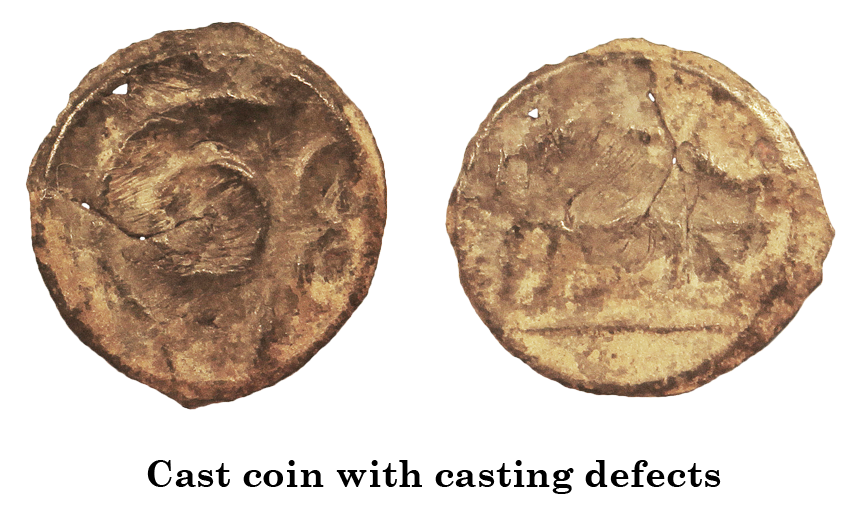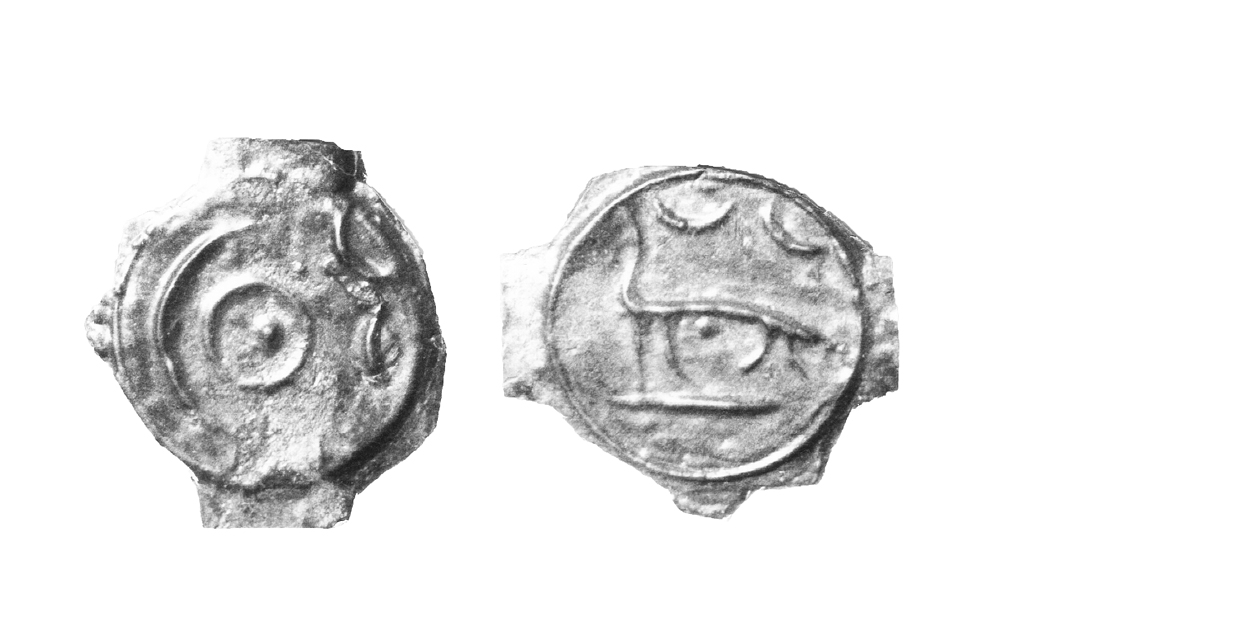
About the Coins
Manufacturing Methods (Info)
Methods of Manufacture
Ancient British coins were manufactured using the normal methods (97) – striking and casting – however, our understanding of the techniques is changing rapidly. Studies of metallurgy, mould-making and die-cutting demonstrate the Celts employed an exceptional level of technology. The knowledge of the moneyers, more advanced than previously thought, is forcing a reassessment of the "barbarian" label imposed by the Romans. The British tribes, once thought to have imported Roman technicians to teach them how to produce better coins, are now seen controlling complex alloys with great precision, alloys the Romans never used for coins.
The Romans have long been known to debase their coins during times of economic stress and doing so with an eye to public sensibilities. They changed weights and finenesses gradually and sometimes resorted to striking plated pieces. These ploys are simplistic, however, compared to the sophisticated schemes used by the Celts. The Celtic moneyers made almost imperceptible, yet simultaneous modifications to weights and tri-metallic alloys, demonstrating an incredible application of technology to the solution of their economic problems.
There is little question the following information will have to be modified as die studies and metallurgical analyses expand our knowledge of the workings of a Celtic mint. The results will give us a better understanding of the monetary policies of the tribal leaders, as well. Today, these are only beginning to be understood, but the changes will only reinforce the sophistication of the coinage and the people responsible for it.
The Die-Struck Coinages
At one time, it was sufficient to describe a Celtic mint as little more than a blacksmith hammering flans between dies crudely engraved with lines and dots. All Celtic coinage was "imitative", so the manufacturing techniques were expected to be little better. Today, there is little agreement about the methods used to cast the flans, much less the alloying techniques. The technologies are more complex than once thought and the moneyers must have been specialized craftsmen to a degree. This is especially true in the later periods when coins were produced in astounding numbers and a mint would have provided full-time employment.
Flan Production
Two methods of flan-production have been suggested, both plausible. The arguments for choosing between them are irrelevant because both were probably used.
The first technique, the "Flat Rock Method" (98), involved ladling blobs of molten metal directly onto a surface such as a flat rock. With practice, the pourer could attain considerable accuracy, and weight adjustments would be minimal. The molten metal's surface tension would cause the flans to be dome-shaped – ideal for centering on a concave obverse die. The shape would also help in striking up the image on the characteristically dish-shaped coins. The flans would have smooth edges and would not require pre-forming or edge shaping before striking. The efficiency of the technique was primarily a matter of the percentage of flans that could be poured to standard weight. Since Celtic coins appear to have been struck to a tolerance approaching plus or minus 0.05 grammes, the skill demanded of the flan-pourer was considerable.
The second technique, the "Muffin-Mould Method" (99), involved casting the flans in clay moulds and then hammering them to shape prior to striking. The moulds supposedly used in this manufacturing process have been found in large numbers on every known mint-site. However, it should be pointed out the presence of the moulds has been used to prove the existence of a mint. Thus, a circular argument exists in which mint sites yield moulds and sites that yield moulds are mint sites. Fortunately, mints sites are also identified by the mint-names on coins, and all these sites have yielded moulds. Metallurgical studies of metal traces in the moulds have identified gold and silver alloys, strengthening the assertion the moulds were used to produce coin flans.
Reconstructions of the moulds have shown them to be of flat clay, almost square, but actually pentagonal. Seven rows of seven circular cavities, with an added cavity in the point of the pentagon produced fifty flans at a time. Two sizes of cavities are known, one about the size of the larger gold staters and the other about that of the smaller silver pieces. The smaller-cavity moulds are the commoner type, this would be expected because gold staters would be produced in smaller numbers.
The method of filling the mould cavities is a controversial topic in itself. Molten metal could be poured into the moulds directly, though this is not felt to be the method used. It would have the same skill demands on pouring as the Flat Rock Method. Instead, it has been suggested granules of metals were weighed out and placed in the cavities. These were then fused by two methods: either the entire mould was fired in a kiln or the individual cavities were fired by means of a blow torch (100). In the second method, by blowing air through a hollow tube, over a hot charcoal, and directly onto the granules, sufficient heat was produced to fuse the metal.
Thermo-Remanent Magnetic studies have proven the moulds were last subjected to heat in a horizontal position, with the cavities uppermost (101). Whenever clay is fired, its magnetic properties are modified. The analysis technique measures these properties and compares them to the magnetic field of the earth to determine the orientation of the clay during its last firing. The orientation of the moulds during their last use supports the hypothesis they were used to cast molten metals.
Signs of vitrification (102) from intense heat on the bottoms of some moulds support the method by which the entire mould was fired in a kiln to fuse the granules. However, other moulds from Villenueve-Saint-Germain, France, were found with little holed covers made of clay, used to allow a blow torch access while at the same time containing its heat. Thus, it is likely both techniques were used.
Some moulds from Verulamium have been found with traces of calcium carbonate (103) probably from powdered chalk, adhering to the sides of the cavities. These suggest the Celts understood and used mould-release agents to facilitate the removal of the flans from the moulds. Chalk was pressed onto the sides of the cavities to prevent the metal from sticking to the walls.
Flans produced by the Muffin-Mould Method would have irregular edges, whereas the actual coins have smooth edges, sometimes with cracks. Thus, the mould-cast flans cannot have been used directly for striking. They would have been first hammered to the optimum thickness and then hammered around the edges to produce smooth surfaces. The additional pre-forming steps involved in the Muffin-Mould Method is not necessarily a reason to condemn the technique. Efficiencies would be obtained by the accuracy of the flan weights produced by weighing the granules prior to firing.
Next Section – Metallurgy

